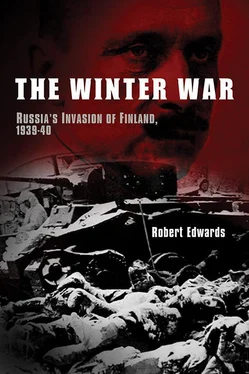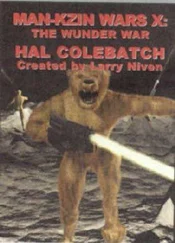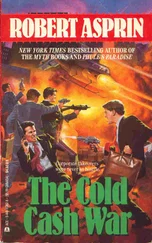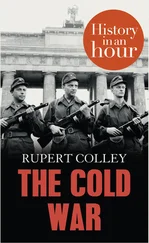Two types of officer suffered the most under the purges: the old Bolsheviks and the ex-Imperial cadres. By 1939, though, 50 per cent of the Officer Corps were Party members, a much greater proportion than the Red Army as a whole, which was seldom more than 20 per cent and in some cases as low as 4–5 per cent.
The Vistula—The History of the 1920 Campaign. The issue revolved around the conduct of the campaign in Poland in 1920. Tukhachevski had been unwise enough to tell anyone who would listen that the conduct of the First Cavalry Army had in effect cost the Red Army the battle of Warsaw. Unhappily, the three senior men in that unit were Stalin, Voroshilov and Budenny.
See the profile of Voroshilov by General Dmitri Volkogonov in Stalin’s Generals (ed. H. Shukman) and marvel.
Zek—from Zachlyuchennyi—prisoner, in this case a slave worker.
It lay, undiscovered and clearly unloved, lacking even an opus number, for over sixty years. See Daily Telegraph, ‘Party piece uncovered’, 6 September 2001.
van Dyke, op cit. , p. 20, cites G. L. Rozanov, Stalin/Hitler (Moscow, 1991) as the source for this.
At the same time another Swede, Birger Dahlerus, also a friend of Göring’s, had been acting as a semi-official diplomatist between Berlin and London. The Scandinavian crisis rather served to switch his attention.
Tanner, The Winter War, p. 74. Mannerheim was not bluffing; he really believed it.
Ibid. p. 72.
The official paper of the Russian Navy.
Tanner, op. cit., p. 79.
See Gilbert, finest Hour, pp. 99–100.
Estonia and Finland share much in historical and cultural terms, notably a similarity of language.
Quoted in the New York Times, 18 November 1939.
A translation of the article can be found in Bror Laurla, The Road to the Winter War, (Finland, 1978).
Tanner, op. cit., pp. 85–6.
Elliston, Finland Fights, p. 177.
The same day, a Red Army patrol had crossed the border at Petsamo and kidnapped three Finnish border guards.
Tanner, op. cit., p. 87.
Mannerheim to Kallio, 27 November, 1939.
Meretskov, Serving the People , (Progress, 1991).
Known to the Russians as Khotinen.
The Soviet-Finnish Campaign, 1939–40. The authors of this, W. P. and Zelda Coates, had ‘form’ as Soviet propagandists. The leaden and unpromising titles of their previous oeuvre— The First Five Year Plan, followed by a truly brain-numbing sequel The Second Five Year Plan— and so on, rather set the tone. To be fair, they were doing a job of work as agents of the Comintern, but the author of the foreword, Frank Owen, editor of the Evening Standard (he of Guilty Men), really should have known better. Examples of the work of this husband-and-wife team can still be found from time to time (this writer bought one at a Sussex village fete, of all places) and they are almost the perfect exemplar of the mare-eyed, fellow-travelling left at its most creatively risible.
Quite simply because by the time the book was published, the line was safely in Russian hands.
The ‘million’ bunker, near Summa, had cost just that; 1 million markka, about £5,000, in 1937.
i.e. the concrete had no steel reinforcing bars, merely granite rubble to improve its density.
Elliston, Finland Fights, p. 142.
Typically, the First World War Russian version of the Maxim from the Imperial factory at Tula. These were of 7.92mm rifle calibre. Foreign weapons arrived in a bewildering variety of calibres. Similarly, the Finns were to employ grenades from no less than seven different origins (with differing fuses) that were thus perilous to use.
Soon to be obsolete, given the rapid developments in tank design.
The Finnish tank park consisted of twenty-year-old Renault models, leavened by a few Carden-Vickers types most of which, for reasons of economy, were unarmed.
It is reasonable to suppose, indeed, it would be irresponsible not to suppose, that the terrified atmosphere generated by the savage purges had something to do with Kuusinen’s boundless enthusiasm for this hopeless project.
See Goodrich, A Study in Sisu. pp. 52–3.
Eventually, after the war, he did return to Finland, disavowed the cause and joined Tanner’s Social Democrat Party, he later became a newspaper editor in the industrial city of Tampere.
politichesky rukovotidel, a political ‘adviser’ attachéd to the military.
Raymond L. Garthoff, How Russia Makes War: Soviet Military Doctrine, p. 257.
Pravda’s expression.
The Soviet T-26 was a near copy of a Vickers 6-ton tank of the early 1930s, and just as useless, but still terrifying to an inexperienced infantryman.
i.e. Great Britain—never let it be said that it might have been Germany.
The translation is from Elliston, op. cit., pp. 230 and 237.
The Finns, justifiably, were and are rather proud of their paper industry. Many of these leaflets were put to more ‘informal’ use.
And his deputy, Mauri Rosenberg, another Finnish exile from 1918.
Screen, Mannerheim, vol. II, pp. 137–8.
Order of the Day No. 1, 1 December 1939.
This may have been an ill-reported sighting of a Finnish armoured car, but records (like memories) are vague.
See van Dyke, Soviet Invasion of Finland, ch. 2, n. 91.
Perhaps oddly, he was not executed, but given a harmless job in administration, where he proved just as incompetent.
Daily Mail, 2 December 1939.
As a gentleman, that is; it was not considered ‘proper’ (and still isn’t) for an officer of below field rank (major) to keep that title upon resignation or retirement.
John Colville, Downing Street Diaries, vol. I.
The Diaries of Beatrice Webb, vol. IV, p. 441.
Daily Telegraph (from Copenhagen), 2 December 1939.
The Times , 2 December 1939.
Читать дальше











